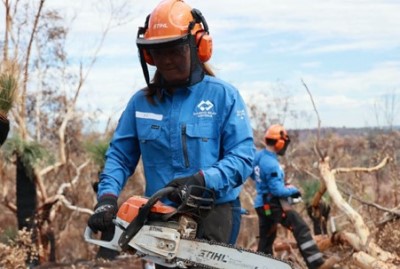Helping hands


Severe storms battered Australia’s eastern coast throughout Boxing Day last year, flooding streets in the Gold Coast as well as downing trees and causing power outages. The damage was estimated to cost more than US$1.3 billion, and 10 people were killed.
Many Australians expected the Australian Defence Force to arrive to contain the damage and organize the cleanup, as has become the norm in recent years. The day after the storms, the Queensland government even requested military assistance. But for the first time ever during a natural disaster, the federal government denied this request. They called instead on the non-profit organization Disaster Relief Australia to help affected communities put their lives back together.

“The military needs to be focused on their primary mission of protecting the nation,” Geoff Evans, Co-Founder and CEO of Disaster Relief Australia, tells The CEO Magazine. “So there needs to be an alternative to handle natural disasters.”
Disaster Relief Australia’s emergence onto Australia’s disaster response scene in 2016 gave the organization just the right amount of time to mature before government policy would make its existence essential.
In 2023, the federal government released its independent Defence Strategic Review, which advised that the military should be used only as the last resort, and only in extreme circumstances, when responding to domestic disasters. Long-term reliance on the Australian Defence Force for natural disasters, the review said, is “unsustainable given Australia’s more complex geostrategic environment”.
“Over the last year, the Australian government has been building the will to say no to a request for military assistance in response to a disaster,” Evans says.

“If you put scaffolding around the spontaneous volunteers and a good command and control team to lead on the ground, they are a fantastic force multiplier.”
“But to be able to say no to a request for military assistance from one of the states, the federal government needs to be able to provide an alternative – that’s where we come in.”
Before the Boxing Day storms, there was no proven alternative. Disaster Relief Australia was the first to be tested in a real disaster scenario.
“It’s pretty exciting for us,” Evans says. “We’re building the army that gets the Army out of disasters.”
Evans’ characterization of Disaster Relief Australia as an army is more literal than it might sound. Most of the organization’s staff and volunteers are military veterans, many of whom have served overseas – including Evans himself.
“If you can operate safely in a war zone, you can definitely operate safely in a disaster zone,” he explains. “You carry the inherent skills in leadership, working in austere environments and the ability to use your initiative. It actually makes a lot of sense to retrain veterans in disaster relief.”

“The key to Disaster Relief Australia is that we offer a sense of purpose through serving others.”
When he started setting up Disaster Relief Australia, Evans had recently returned home from Afghanistan with 19 years in special operations under his belt.
“I’d been wounded in action in Afghanistan, and I was medically discharged from the military,” he recalls. “I was pretty lost with what I was going to do with my life.”
He looked around and saw he was not the only one. The country was full of veterans coming back from the Middle East with specialized skills and no way to apply them.
“If you don’t have a purpose in your life – a sense of importance and a reason to get up in the morning – you’ll never make a successful transition,” Evans points out. “The key to Disaster Relief Australia is that we offer a sense of purpose through serving others.”
Science backs this up. The South Australian Health and Medical Research Institute released a report this year that found that volunteering with Disaster Relief Australia provides significant mental health benefits, especially for military veterans.
“We offer a huge missing piece of the puzzle in terms of transition and reintegration of veterans through emergency services,” he adds.
However, the benefits of contributing to disaster relief are not reserved for veterans. A significant portion of Disaster Relief Australia’s success comes from its volunteering model, which brings in impressive numbers of people offering their time and labor, even while volunteering numbers are on the decline elsewhere.
“There are thousands of people out there who are willing to help after a disaster, but they don’t know where to go,” Evans says.
Disaster Relief Australia addresses this problem through its system of spontaneous volunteering. This allows local people to join the recovery effort after disaster strikes and contribute as much time as they are able.
“If a major disaster happens in your backyard, you might give us a week or three days, and we give you the flexibility to come in and volunteer,” Evans says. “We might never see you again and that’s OK. No drama.”

“There are thousands of people out there who are willing to help after a disaster, but they don’t know where to go.”
Volunteers are placed in teams led by the organization’s trained experts – often veterans.
“If you put scaffolding around the spontaneous volunteers and a good command and control team to lead on the ground, they are a fantastic force multiplier,” Evans confirms.
Disaster Relief Australia also opens up its operations to corporate volunteers – companies that want to donate their time to a good cause as a unit.
“We’ve never made money from corporate volunteering,” Evans says. “It’s not about money. It’s about the fact that many fingers make light work.”

With Disaster Relief Australia responsible for clearing the rubble in the aftermath of a disaster, local councils have more time and freedom to focus on rebuilding. Australia’s federal government releases grants to local councils for this purpose, but the councils are often too overwhelmed to apply for them or administer them.
“Billions of dollars just go to waste because the councils that need the money are just too overwhelmed. These are mostly rural and regional councils that were cash-strapped and struggling even before the disaster hit them,” Evans notes.
Its corporate volunteers, like the National Australia Bank, can apply their professional skills to helping the councils take advantage of these much-needed grants.
“We’re starting to bring in corporate volunteers to assist the councils to apply for grants and then administer them so they can actually recover,” Evans reveals.
Through this robust volunteer program, Disaster Relief Australia is able to expose people from all walks of life to the benefits of public service that Evans and his veteran colleagues have picked up over their years in the military.
“I think that gets into your blood and it doesn’t go away just because you leave uniform service,” he reflects. “You always have this desire to continue to serve.”
This article was originally published by CEO Magazine by author Jacob Goldberg.
The articles may contain material provided by third parties derived from sources believed to be accurate at its issue date. While such material is published with necessary permission, the Westpac Group accepts no responsibility for the accuracy or completeness of, nor does it endorse any such third-party material. To the maximum extent permitted by law, we intend by this notice to exclude liability for third-party material. Further, the information provided does not take into account your personal objectives, financial situation or needs and so you should consider its appropriateness, having regard to your personal objectives, financial situation and needs before acting on it.